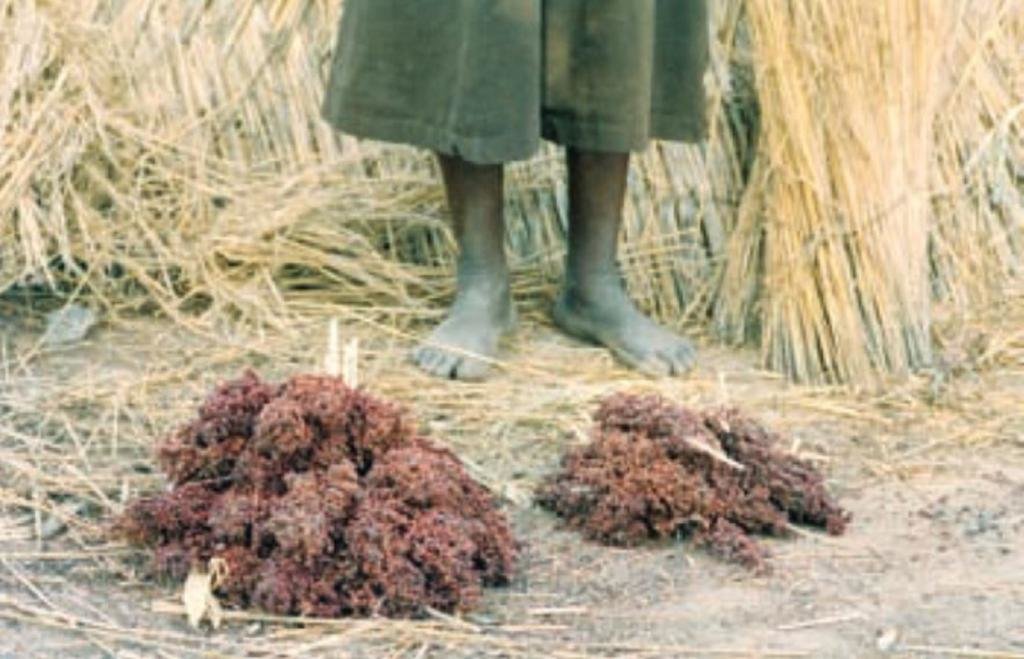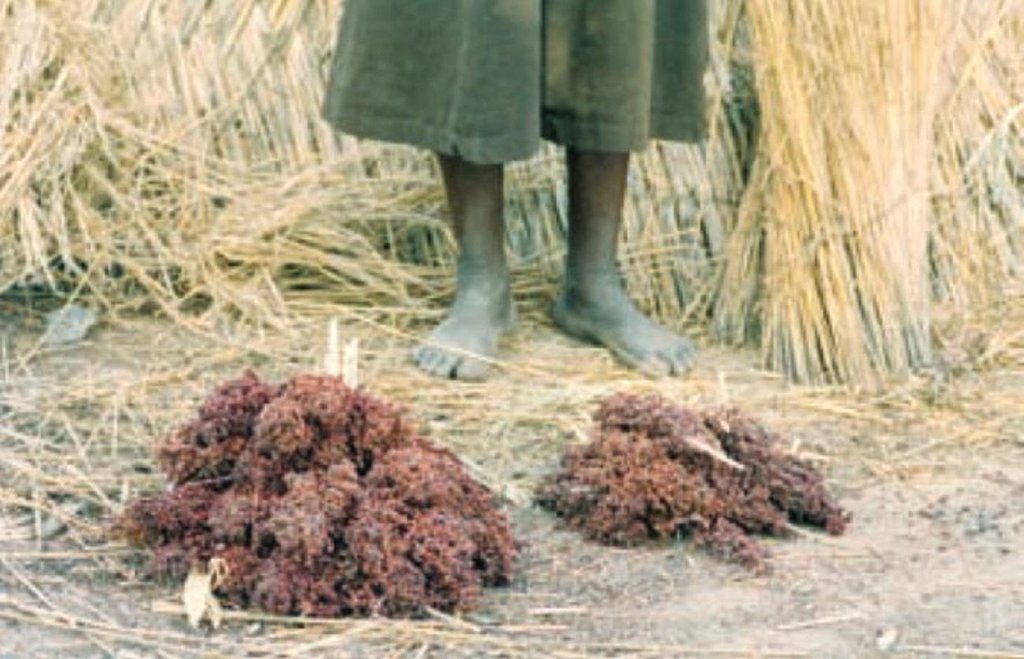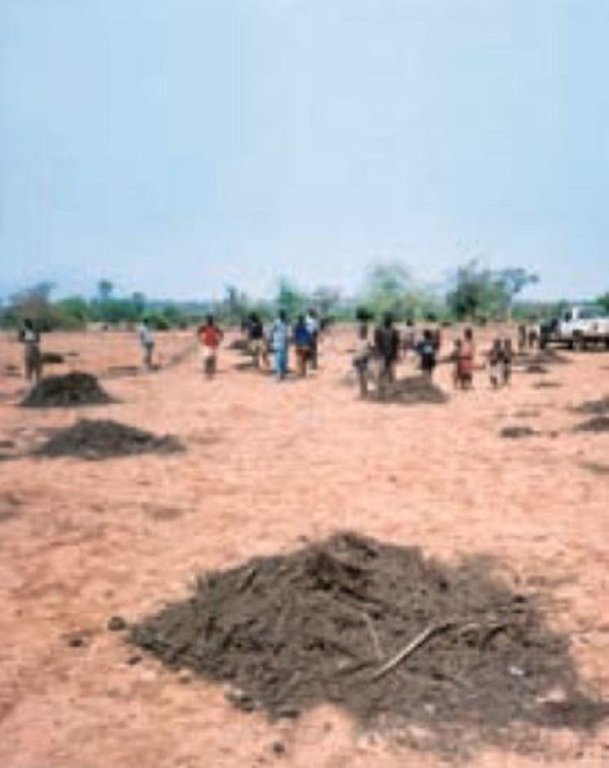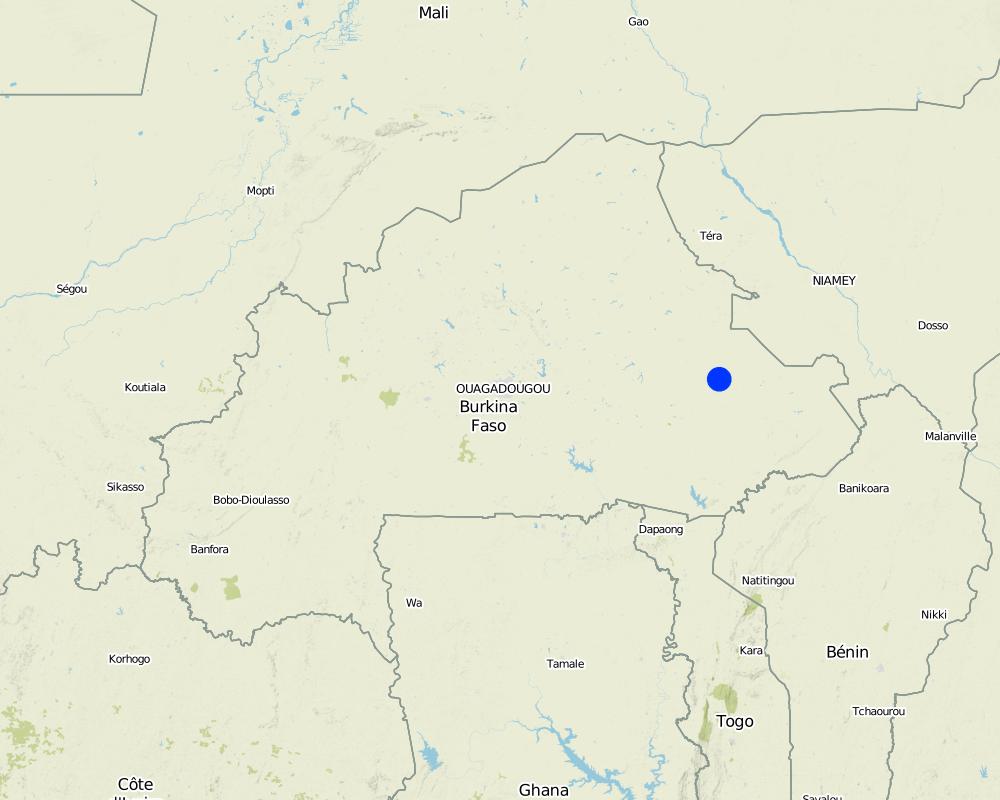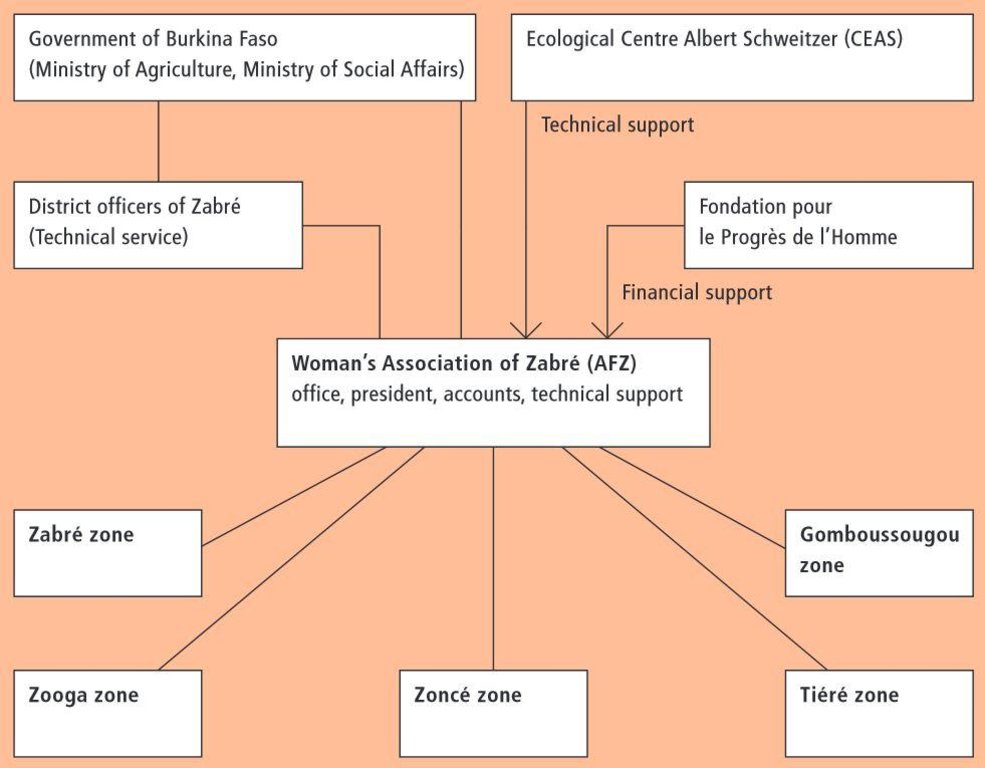Zabré women’s agroecological programme [บูร์กินาฟาโซ]
- ผู้สร้างสรรค์:
- การอัพเดท:
- ผู้รวบรวม: Unknown User
- ผู้เรียบเรียง: –
- ผู้ตรวจสอบ: David Streiff, Deborah Niggli
approaches_2405 - บูร์กินาฟาโซ
ดูส่วนย่อย
ขยายทั้งหมด ย่อทั้งหมด1. ข้อมูลทั่วไป
1.2 รายละเอียดที่ติดต่อได้ของผู้รวบรวมและองค์กรที่เกี่ยวข้องในการประเมินและการจัดเตรียมทำเอกสารของแนวทาง
วิทยากรหลัก
ผู้เชี่ยวชาญ SLM:
Lougue Maria
Association des femmes Pag-La-Yiri de Zabré (AFZ)
O9 B.P. 335 Ouagadougou 09,
ผู้เชี่ยวชาญ SLM:
De Pury Jean Pascal Etienne
ceas.ne@bluewin.ch / ceas-rb@fasonet.bf
ancien directeur du Centre Ecologique Albert Schweitzer
CH-2000 NeuchâFtel, Switzerland, 2 rue de la Côte,
สวิตเซอร์แลนด์
ชื่อของโครงการซึ่งอำนวยความสะดวกในการทำเอกสารหรือการประเมินแนวทาง (ถ้าเกี่ยวข้อง)
Book project: where the land is greener - Case Studies and Analysis of Soil and Water Conservation Initiatives Worldwide (where the land is greener)ชื่อของโครงการซึ่งอำนวยความสะดวกในการทำเอกสารหรือการประเมินแนวทาง (ถ้าเกี่ยวข้อง)
Centre Ecologique Albert Schweitzer (CEAS) - สวิตเซอร์แลนด์1.3 เงื่อนไขที่เกี่ยวข้องกับการใช้ข้อมูลที่ได้บันทึกไว้ผ่านทาง WOCAT
ผู้รวบรวมและวิทยากรหลักยอมรับเงื่อนไขเกี่ยวกับการใช้ข้อมูลที่ถูกบันทึกผ่านทาง WOCAT:
ใช่
1.4 การอ้างอิงถึงแบบสอบถามเรื่องเทคโนโลยี SLM
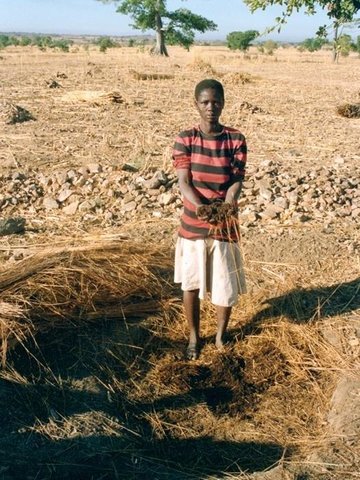
Composting associated with planting pits [บูร์กินาฟาโซ]
Compost production, and its application in planting pits (zai) by farmers on fields near their homes.
- ผู้รวบรวม: Moussa Bonzi
2. คำอธิบายของแนวทาง SLM
2.1 การอธิบายแบบสั้น ๆ ของแนวทาง
A demand-driven initiative, by a women’s association, aimed at the promotion of composting through training and extension, using project staff and local facilitators.
2.2 การอธิบายอย่างละเอียดของแนวทาง
การอธิบายอย่างละเอียดของแนวทาง:
Aims / objectives: Leaders of the women’s association of Zabré (Association des Femme de Zabré, AFZ) initiated a training programme for their members on compost making, and its application in planting pits (zai) after they visited a seminar on the topic in 1987. AFZ actively sought technical and financial help, and found this through the Centre Ecologique Albert Schweitzer (CEAS, based in Switzerland). Support began with the establishment of a first demonstration site where five local facilitators (one from each zone), learned about and developed the technology together over a whole year - comparing the results with sorghum fields without compost. In the following year, those five facilitators each trained 20 women in their zones, using the same training methods as they themselves had experienced. AFZ set up demonstration and training sites in each of the five zones. These demonstration areas were protected by a wire netting fence, contained a well, a cement water tank, and some shade trees for the compost heaps and training sessions. Machines for the wells, hand tools and manure were fully financed, whereas community infrastructure was only partly funded. Each demonstration site had one hectare of cultivated land, with irrigated vegetables in the dry season and sorghum in the rainy season. The facilitators used this land to demonstrate the effect of the compost, and thus to visually convince the trainees. Each of the trainees carried 20 kg of compost home and applied it to their own sorghum fields. During the first 18 months, a CEAS technician visited the zones regularly.
Methods: In the following years, the neighbouring villages each sent groups of 20 women to the established demonstration and training sites, each group for one day a week. They carried out the successive phases of composting in the demonstration plots, while simultaneously implementing the practice at home - where they were supervised by the facilitators as far as possible. In this way, 500 women were trained within one year. Although it took a while, men gradually began to take part and assist their wives when they lost their fear of being ridiculed by others. Many more women then put themselves forward for training. While waiting, they tried to imitate their neighbours, but with mixed results. The support of the CEAS project decreased over the years until 1997, after which it was phased out, being no longer necessary. Training has since continued through the five zonal facilitators and the local agriculture extension service.
2.3 รูปภาพของแนวทาง
2.5 ประเทศ ภูมิภาค หรือสถานที่ตั้งที่ได้นำแนวทางไปใช้
ประเทศ:
บูร์กินาฟาโซ
ภูมิภาค/รัฐ/จังหวัด: :
Boulgou Province
Map
×2.6 วันที่เริ่มต้นและสิ้นสุดของแนวทาง
ระบุปีที่เริ่ม:
1987
การสิ้นสุดลง (ถ้าแนวทางไม่ได้ใช้อีกต่อไป):
1997
2.7 ประเภทของแนวทาง
- ใช้โครงงานหรือแผนงานเป็นฐาน
2.8 เป้าหมายหรือวัตถุประสงค์หลักของแนวทาง
- train 6,000 women members of AFZ (in 1987) in making compost, and applying it to planting pits (zai) in order to double yields of sorghum or maize - the eventual target is for all farmers of the two departments to make, and apply compost on their fields, - improve the status of women and their livelihoods, - encourage women’s participation in development, - promote training and cooperative action
The SLM Approach addressed the following problems: Since the drought and famine periods of 1970-74 and 1981-84, the main concern of the women in Zabré was how to feed their families. This meant trying to raise crop production again to the pre-1970s average of 800 kg/ha from the level of 400 kg/ha to which it had fallen. The soils were deteriorating because of declining organic matter as increased population led to continuous cultivation without fallow periods. The status of women was low, and they found it hard to generate income through other activities.
2.9 เงื่อนไขที่เอื้ออำนวยหรือเป็นอุปสรรคต่อการนำเทคโนโลยีภายใต้แนวทางนี้ไปปฏิบัติใช้
บรรทัดฐานและค่านิยมทางสังคม วัฒนธรรม ศาสนา
- เป็นอุปสรรค
Men were afraid of being ridiculed in case of failures.
Treatment through the SLM Approach: Contrastingly, women don’t fear being laughed at. The expectation of increasing the yields encourages them to take risks: eventually men also followed for the same reasons.
การมีไว้ให้หรือการเข้าถึงแหล่งการเงินและบริการ
- เป็นอุปสรรค
Training of farmers is relatively expensive.
Treatment through the SLM Approach: The donors (Fondation pour le Progrés de l'Homme) and CEAS took care of the approach costs.
การจัดตั้งระดับองค์กร
- เป็นอุปสรรค
The existing institution of the women’s association of Zabré (AFZ), which has functioned well for 12 years, needed to adapt to the new agroecological programme promoted by CEAS.
Treatment through the SLM Approach: The management of the AFZ was motivated to adopt and integrate the technology offered by CEAS.
กรอบแนวทางในการดำเนินการด้านกฎหมาย (การถือครองที่ดิน สิทธิในการใช้ที่ดินและน้ำ)
- เอื้ออำนวย
Even though the land users do not own the land they cultivate (the state officially owns the land, though land use rights are traditional and secure) they receive immediate and full benefits through improved crop yields.
- เป็นอุปสรรค
ความรู้เกี่ยวกับ SLM การเข้าถึงการสนับสนุนด้านเทคนิค
- เป็นอุปสรรค
One key question was: how best to teach composting to 6,000 women?
Treatment through the SLM Approach: AFZ already had an extension structure and the five facilitators served as ‘multipliers’
3. การมีส่วนร่วมและบทบาทของผู้มีส่วนได้ส่วนเสียที่เกี่ยวข้อง
3.1 ผู้มีส่วนได้ส่วนเสียที่เกี่ยวข้องในแนวทางนี้และบทบาท
- ผู้ใช้ที่ดินระดับท้องถิ่นหรือชุมชนระดับท้องถิ่น
There were great differences - in the beginning at least - when AFZ merely asked the men to ‘allow’ their wives to learn about composting. After two years, men started to participate in the training and eventually as many of them as women began to make and use compost. Another difference was in discussions, when men tended to dominate.
- ผู้เชี่ยวชาญ SLM หรือที่ปรึกษาการเกษตร
- องค์การระหว่างประเทศ
- AFZ
Leaders of the women's association of Zabré
3.2 การเกี่ยวข้องของผู้ใช้ที่ดินระดับท้องถิ่นหรือชุมชนระดับท้องถิ่นในช่วงต่างๆของแนวทาง
| ความเกี่ยวข้องของผู้ใช้ที่ดินระดับท้องถิ่นหรือชุมชนระดับท้องถิ่น | ระบุผู้ที่มีส่วนเกี่ยวข้องและอธิบายกิจกรรม | |
|---|---|---|
| การริเริ่มหรือการจูงใจ | ปฏิสัมพันธ์ | discussion of problems in public meetings |
| การวางแผน | ปฏิสัมพันธ์ | meetings with those in charge of the groups of women farmers |
| การดำเนินการ | ปฏิสัมพันธ์ | in exchange for the training received, some land users volunteered themselves as temporary/part-time facilitators |
| การติดตามตรวจสอบหรือการประเมินผล | ปฏิสัมพันธ์ | the land users learned to control the quality and the efficiency of their work and voluntarily contributed to monitoring/evaluation - the facilitators were responsible for progress reports |
| Research | ไม่ลงมือ | visit of international researchers to the farms |
3.3 แผนผังแสดงขั้นตอนการทำงาน (ถ้ามี)
คำอธิบาย:
The agroecological programme of the Zabré Women's Association (AFZ). There are five facilitator’s zones each with:
- 1 president, 1 vice-president
- 1 facilitator
- 1 pharmacy
- 1 cereal bank
- 1 meeting room
- 1 shop
- 1 demonstration/training site
3.4 การตัดสินใจเลือกใช้เทคโนโลยี SLM
ระบุผู้ที่ทำการตัดสินใจเลือกเทคโนโลยีมากกว่าหนึ่งวิธีไปปฏิบัติใช้:
- Leaders of the women's association of Zabré (AFZ)
การอธิบาย:
in consultation with experts from the Centre Ecologique Albert Schweitzer (CEAS).
Decisions on the method of implementing the SLM Technology were made by Leaders of the women's association of Zabré (AFZ). CEAS, their engineers at Zabré and the facilitators designed the approach, which fitted well into the existing structure of AFZ.
4. การสนับสนุนด้านเทคนิค การสร้างขีดความสามารถ และการจัดการด้านความรู้
4.1 การสร้างขีดความสามารถ / การอบรม
ได้มีการจัดอบรมให้แก่ผู้ใช้ที่ดินหรือผู้มีส่วนได้ส่วนเสียคนอื่น ๆ หรือไม่:
ใช่
รูปแบบการอบรม:
- เกษตรกรกับเกษตรกร
- ใช้พื้นที่ทำการสาธิต
- จัดการประชุมสู่สาธารณชน
- จัดคอร์ส
รูปแบบการอบรม:
- on-farm training
หัวข้อที่พูด:
Training, as the central focus of the approach, was provided on two levels: project staff trained local facilitators, who then further spread the gained SWC knowledge among the land users. Subjects treated included compost making and application, reforestation, soil protection and anti-erosion measures. station training.
4.2 การบริการให้คำแนะนำ
ผู้ใช้ที่ดินมีการเข้าถึงการรับบริการให้คำปรึกษาหรือไม่:
ใช่
ระบุว่ามีบริการให้คำปรึกษาหรือไม่:
- ไปเยี่ยมชมสถานที่
การอธิบาย/แสดงความคิดเห็น:
Key elements: demonstrations and practical training of of AFZ’s members in the five demonstrationareas in the respective AFZ zones.
4.3 การเสริมความแข็งแกร่งให้กับสถาบัน (การพัฒนาองค์กร)
สถาบันได้รับการจัดตั้งขึ้นมาหรือเสริมความแข็งแกร่งโดยแนวทางนี้หรือไม่:
- ใช่ อย่างมาก
ระบุระดับของสถาบันที่ได้รับการเสริมความแข็งแกร่งหรือจัดตั้งขึ้นมา:
- ท้องถิ่น
ระบุประเภทของการให้ความช่วยเหลือสนับสนุน:
- ด้านการเงิน
- การสร้างขีดความสามารถ / การอบรม
- อุปกรณ์
4.4 การติดตามตรวจสอบและประเมินผล
การติดตามตรวจสอบและประเมินผลเป็นส่วนหนึ่งของแนวทางหรือไม่:
ใช่
ความคิดเห็น:
bio-physical aspects were regular monitored by 0 through observations; indicators: colour, texture and temperature of compost
technical aspects were regular monitored by 0 through observations; indicators: learning progress and production
socio-cultural aspects were ad hoc monitored by 0 through observations; indicators: effects on input and product prices
economic / production aspects were regular monitored by 0 through measurements; indicators: agricultural output
area treated aspects were regular monitored by 0 through observations; indicators: fields with compost
no. of land users involved aspects were regular monitored by 0 through observations; indicators: trained land users and implementers of technology
management of Approach aspects were regular monitored by 0 through measurements; indicators: CEAS' accounting expertise
There were no changes in the Approach as a result of monitoring and evaluation
4.5 การวิจัย
การวิจัยเป็นส่วนหนึ่งของแนวทางหรือไม่:
ใช่
ให้ข้อมูลเพิ่มเติมและให้ระบุผู้ทำการวิจัย:
Applied research was not part of this approach. However CEAS used previous recommendations from an applied research station in Gorom (Burkina Faso) and thereby adapted the technology to the local situation.
5. การสนับสนุนด้านการเงินและวัสดุอุปกรณ์
5.1 ระบุงบประมาณประจำปีสำหรับแนวทาง SLM นี้
แสดงความคิดเห็น (แหล่งของการระดมทุน ผู้บริจาคคนสำคัญ):
Approach costs were met by the following donors: international (CEAS&Fondation pour le progrés del'homme): 80.0%; government (national): 20.0%
5.2 การสนับสนุนด้านการเงิน / วัสดุอุปกรณ์ให้แก่ผู้ใช้ที่ดิน
ผู้ใช้ที่ดินได้รับการสนับสนุนด้านการเงิน / วัสดุอุปกรณ์ไปปฏิบัติใช้เทคโนโลยีหรือไม่:
ใช่
5.3 เงินสนับสนุนสำหรับปัจจัยนำเข้า (รวมถึงแรงงาน)
- อุปกรณ์
| ระบุปัจจัยนำเข้าที่ได้รับการสนับสนุน | เห็นด้วยระดับไหน | ระบุเงินสนับสนุน |
|---|---|---|
| เครื่องจักร | ได้รับการช่วยเหลือทางการเงินแบบเต็ม | machines for the wells on demonstration areas |
| เครื่องมือ | ได้รับการช่วยเหลือทางการเงินแบบเต็ม | |
- การเกษตร
| ระบุปัจจัยนำเข้าที่ได้รับการสนับสนุน | เห็นด้วยระดับไหน | ระบุเงินสนับสนุน |
|---|---|---|
| manure | ได้รับการช่วยเหลือทางการเงินแบบเต็ม | |
- โครงสร้างพื้นฐาน
| ระบุปัจจัยนำเข้าที่ได้รับการสนับสนุน | เห็นด้วยระดับไหน | ระบุเงินสนับสนุน |
|---|---|---|
| ommunity infrastructure | ได้รับการช่วยเหลือทางการเงินแบบเต็ม | |
ถ้าแรงงานโดยผู้ใช้ที่ดินเป็นปัจจัยนำเข้าที่มีอยู่มากมาย ระบุด้วยว่าเนื่องจาก:
- สมัครใจ
ความคิดเห็น:
the hope of increasing yields served as an effective incentive.
5.4 เครดิต
มีการจัดหาเครดิตมาให้ภายใต้แนวทาง SLM หรือไม่:
ไม่ใช่
6. การวิเคราะห์ผลกระทบและการสรุป
6.1 ผลกระทบของแนวทาง
ช่วยให้ผู้ใช้ที่ดินนำเอาเทคโนโลยี SLMไปใช้และบำรุงรักษาสภาพไว้ได้หรือไม่:
- ไม่ใช่
- ใช่ เล็กน้อย
- ใช่ ปานกลาง
- ใช่ อย่างมาก
The compost making and its application has helped to improve soil and water management, as the compost returns humus to the soil and increases its water retention capacity and thus improves ground cover.
Did other land users / projects adopt the Approach?
- ไม่ใช่
- ใช่ เล็กน้อย
- ใช่ ปานกลาง
- ใช่ อย่างมาก
Many women's groups from other regions throughout the country invite delegations from AFZ to teach them compost making. The AFZ delegates are provided with food, accommodation, travel costs and presents in exchange for training. This is much cheaper than the 'official' compost training provided by the Association for Agroecological Technology Development (ADTAE).
6.3 ความยั่งยืนของกิจกรรมของแนวทาง
ผู้ใช้ที่ดินสามารถทำให้สิ่งต่างๆ ที่ได้ปฏิบัติใช้โดยแนวทางนี้ยั่งยืนได้หรือไม่ (โดยไม่มีการสนับสนุนจากภายนอก):
- ใช่
ถ้าตอบว่าใช่ ให้อธิบายว่าอย่างไร :
The land users are continuing activities and can do so in future, assuming no new problems arise.
6.4 จุดแข็งและข้อได้เปรียบของแนวทาง
| จุดแข็ง / ข้อได้เปรียบของแนวทางในทัศนคติของผู้รวบรวมหรือวิทยากรหลัก |
|---|
| Land users have confidence in their organisation (AFZ) and learn while working in the fields and discussing with the facilitators (How to sustain/ enhance this strength: The facilitators know to nurture this confidence until the land users get profit from the compost (which in turn reinforces that confidence).) |
| AFZ was convinced about the necessity of compost before they knew about CEAS. They searched for a technical collaborator for training and financial support (How to sustain/ enhance this strength: This preliminary motivation is an asset and the technical partner has to fulfil neither less, nor more, than what AFZ expects.) |
| Training of local trainers/facilitators (How to sustain/ enhance this strength: Positive feedback from the farmers will stimulate the facilitators to continue their work.) |
| AFZ represents female land users, it is local and not 'created' by CEAS and is thus an ideal structure (How to sustain/ enhance this strength: CEAS has the knowledge, but AFZ has the power. AFZ needs to learn to use its power to access CEAS' knowledge bank.) |
6.5 จุดอ่อน / ข้อเสียเปรียบของแนวทางและวิธีในการแก้ไข
| จุดอ่อน / ข้อเสียเปรียบในทัศนคติของผู้รวบรวมหรือวิทยากรหลัก | สามารถแก้ไขปัญหาได้อย่างไร |
|---|---|
| Internal conflicts within the association may cause problems and there is a danger of CEAS specialists becoming involved in these AFZ rivalries | CEAS should be aware of AFZ power struggles and not get involved. CEAS must stick to its technical role - which is related to knowledge only and not to power. |
7. การอ้างอิงและการเชื่อมต่อ
7.1 วิธีการหรือแหล่งข้อมูล
- ไปเยี่ยมชมภาคสนาม การสำรวจพื้นที่ภาคสนาม
- การสัมภาษณ์กับผู้ใช้ที่ดิน
7.2 การอ้างอิงถึงสิ่งตีพิมพ์
ชื่อเรื่อง ผู้เขียน ปี ISBN:
UNEP (2002) Enriching soils naturally. In: Success stories in the struggle against desertification pp 5-8
ชื่อเรื่อง ผู้เขียน ปี ISBN:
UNEP (2002) Enriching soils naturally. In: Success stories in the struggle against desertification pp 5-8
ลิงก์และโมดูล
ขยายทั้งหมด ย่อทั้งหมดลิงก์

Composting associated with planting pits [บูร์กินาฟาโซ]
Compost production, and its application in planting pits (zai) by farmers on fields near their homes.
- ผู้รวบรวม: Moussa Bonzi
โมดูล
ไม่มีโมดูล



